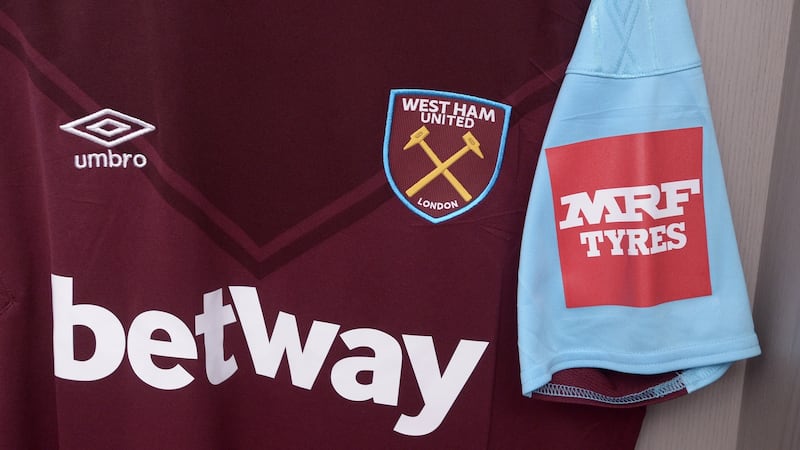Science fiction has long looked at the future of sport and generally settled on one consistent idea; it will be brutal.
By now we were supposed to be obsessed with something like the violent mix of speedway, lacrosse and rollerdisco that was Rollerball. It was meant to be Death Race 2000 and the Running Man. At the very least, there would be futuristic tweaks like silver footballs and three-dimensional chess.

It all smacks of silliness until you look at one of the 21st century’s highest paid sports stars rolling about on the blood-smeared floor of an octagon. Or you see goals being ruled out because a computer spotted that a player’s nasal hair was offside.
Meanwhile, matches take place on artificial pitches surrounded by flashing billboards, with players mic’ed up so they can be interviewed during a game. Those sci-fi ideas don’t seem so ridiculous after all.
And then you see how much modern health, lifestyle and even sport is being driven by how people want to look on Instagram and suddenly realise sci-fi writers didn’t even get to the half of it.
Sport has changed and will change. Quite how it will be in 50 years depends, as always, on how society develops. Sport has long been a mirror of social, economic and technological changes.
“If you look at the use of the word sport itself until a couple of hundred years ago, sport meant – and only meant – going hunting and shooting and fishing, and that’s all gone and sunk to the margins,” explains Paul Rouse, UCD historian, and author of Sport & Ireland: A History.
“Cockfighting was one of the biggest sports in Ireland until the 19th century, huge crowds, a huge amount of gambling, a central point of socialising in urban and rural areas. It now exists only in the margins. So times change and perceptions change and sport completely reflects society. As society changes so sports changes. Some things will rise and some things will fall. Predicting what those are is not straightforward.”
One thing that shows no sign of changing is that, for all the variety of sports – traditional and new – the ‘individualisation’ of sport is not going away.
Since 2007, Sport Ireland and Ipsos MRBI have been tracking this through their Irish Sports Monitor reports. Since that first year, the biggest sport in Ireland has not been Gaelic games or soccer, but ‘exercise’ (primarily gym-work). Of the 10 most popular sports in Ireland, eight are those which people generally do on their own.
Wellness industry
It is a trend that will continue to be pushed by a wellness industry extending from social media and YouTube stars to global shoe corporations, but also by the proliferation in events.
Whether it’s the social aspect of the Park Run, the fun of paint-splattered “colour runs”, the torture of 24-hour races, the mass cycles, the new high-tech gym class, there will always be a need to feed the individual’s needs and to find something new to motivate the lone sportsperson.
For all that running, cycling, walking and the like have helped bring people in to sport, the more traditional clubs will continue to face challenges. However, while history shows us that sports have no right to stay popular forever, some do have an advantage that will see the big sports hold on into the future.

“It would be a fool who would argue that the club structure is going to collapse,” argues Paul Rouse, “not least when you see massive field sports that have huge assets around the place. Assets in everything from pitch space, or outside of fields sports the golf clubs and courses.
“There is a huge real estate issue and a bind that ties clubs together because of the assets they have apart altogether from the sport which they play. Most of all it’s a massive industry. Anything that has such an industry around it, there are vested interest that demand this structure perpetuates itself and even expands.”
It may be that newer sports are more likely to rise and fall in popularity. Those which can turn up at a location, hold an event and then move on again may actually be most vulnerable.
For example, for all its popularity, the triathlon’s massive growth in the US has not just stalled but actually begun to drop alarmingly – down about a quarter in the past five years.
There is a fear that the DIY aspect of the sport has been outpaced by the cost of gear – better bike, better shoes, better wet-suit. According to a recent New York Times article, races are increasingly looking for novel ways to entice entrants, including more scenic courses, or easier routes.
That a sport whose modern form is not yet a half-century old already has to figure out how to make itself new again shows how quickly the cycle can spin.
Interestingly, the triathlon also continued to become a sport for the middle-aged, with the largest group of triathletes now 45-49 years old. That’s a general trend that is seen across Irish sport.
The most recent Irish Sports Monitor found a drop in 16-34 year-olds participating in sport, while women of 35 and older are increasingly likely to do something. In fact, women over 45 are now more likely than men of that age to be involved in some form of sport.
Class based
Meanwhile, there has been a jump in the number of over-65s who are considered “highly active”. It suggests that the future of sport will be older. The events and encouragement will be there regardless of age. The only barrier will be the state of your body.
Although, there will continue to be other barriers.
The rates of Irish people doing any sport at all have been steady for years, at just under half the population, but the big problem in future years will be to break some worryingly stubborn trends.
Sport is still very much class based. The higher the income or better your education, the more likely you are to be involved in a sport. Likewise, there is much to be done with involvement of those with a disability or long-term illness.
There is also the hope that the future will be far more female, with the recent viewing figures for the Women’s World Cup, and star status of the winning US team lauded as a breakthrough (even if they’re still pushing for equal pay).

The status of the All-Ireland women's football final as the most attended women’s final in the world in recent years is also seen as important, and the current 20x20 initiative to boost attendances, media coverage and participation is attempting to be a launchpad for a better future.
There is already a growing visibility of sportswomen across sports that have historically been almost entirely focused on men and yet these are only stepping stones in what has been a slow and frustrating path.
There is no doubt that by 2069 we’ll look back with shame at how imbalanced our view of sport has been. Still, there is no guarantee it will be fully righted. As Rouse says, “you don’t reverse a hundred years of history in just 10 minutes”.
“It is utterly disgraceful that the modern sports revolution is a profoundly male experience,” says Rouse. “Women were treated like chaff. They were treated disgracefully. And what you’re left with is now a changing and hugely evolving emphasis on women’s sport, rightly, but the prejudices of the sport aren’t easily shaken. So it’s going to take time.
“And sport always reflects society, so as society changes it helps drive change but largely reflects it more than anything else.”
Big day
So, while our grandchildren will see many changes, there are many things that will need to have changed by 2069. Still, the hope is that certain things will remain as they ever were.
Despite the shortening attention spans, the competing demands, the cost of tickets, the sheer overloading of our lives with sport, it will still be at the heart of so many lives, communities, families. We will always want the big day out.
“Obviously the growth of pay TV has changed accessibility, and the rise of internet-based technologies change how people consume sport. But it still is the case that the great bulk of people are drawn to love sporting events,” concludes Rouse.
“Sport is almost an excuse for a whole load of things that people love, like drinking and dancing and long evenings out, or even just the sociability of being out with a group of friends travelling to something. Or sitting in the pub and watching something. Or sitting at home, chatting to your friends and watching something. It is a great unifier.”
The Future of the GAA
Another championship summer, another bout of introspection about the current state of the game – football in particular – and what its future might be. The format of both championships have changed significantly in recent years and it may well be that this period will be seen as a time of tinkering on the way to settling into a more lasting structure.
The question of amateurism will not go away. Nor will the place and development of women’s GAA within the clubs and counties. And Dublin’s dominance in football is accompanied by the talk of splitting the county to make it fair on everyone else, but it’s possible that in coming decades we may see even more radical changes.
“It’s at a crossroads,” says Paul Rouse, whose most recent book is The Hurlers: The First All-Ireland Championship and the Making of Modern Hurling.
“The GAA has a lot of very serious thinking to do about population imbalances and where the economic strengths are. It’s not just how many people live in each county but what age they are. This has created an imbalance. And it’s not clear how this is going to play out.”
Rouse stepped in as interim manager of the Offaly football team in 2018, so has a particular insight into these problems. He can see a situation in which struggling counties might look at a once-unthinkable approach.
“If you’re going to talk about splitting Dublin you’ll also have to throw into the mix the amalgamation of other countries who are currently uncompetitive. I think the GAA is crying out for a serious strategic plan for where it is going to and a vision of what the organisation should be and how the vision can be implemented.”
So, look forward to the 2069 football final when North Dublin will be doing their best to stop Waterkenny’s drive for five.

Gambling and sport
You can easily imagine someone in 2069 looking back at early 21st century sport and wondering just what their grandparents were thinking when they allowed betting companies become such a prevalent sponsor and advertiser of some of the world’s biggest clubs and competitions.
Half of the shirts worn by this season’s Premier League teams will be emblazoned by betting company logos, and the sight of pitchside hoardings scrolling through betting odds has become familiar. Gambling has been sold as an integral part of sports, rather than a mere add on.
Much as with the concerns over alcohol sponsorship, and the once heavy reliance on tobacco advertising in sport, it is likely that the reckoning will be slow but there are signs of change. As of this month, there is a “whistle-to-whistle” ban on TV advertising of betting companies during live matches before 9pm.
It is an industry-led initiative, somewhat tempered by the hoardings and shirt sponsors that will still be ever-present, but stand by for a lot more hand-wringing about this in coming years. Even still, don’t expect overnight change. Tobacco companies no longer advertise on Formula 1 cars but they still sponsor their teams.
Money talks, and the odds on that changing are very slim.
Five things we’ll see in the future
1. Tech will drive trends: The rise of sports such as kitesurfing show that ingenuity and engineering can lead to strange and popular hybrids.
2. Free-to-air events: The impact of Pay TV on sports has been huge, but as participation levels drop against a backdrop of low viewing figures, the recent Cricket World Cup final was an example of a sport looking to free-to-air TV for a bigger viewership. Expect more of this.
3. A female future: Rhasidat Adekele and Sarah Healy are among the Irish athletes who could become household names in coming years, but there is still huge room for growth in many sports – both in participating, spectating and general visibility – before we catch up with the great gender imbalance.
4. Farther, fitter, crazier: As we've seen through adventure races like Tough Mudder or the rise of Ironman events, the future will provide for those looking to find a fun and/or tortuous way to push themselves.
5. Never giving up: People are not just participating in sports at an older age, but starting them late. "Masters" sport is increasingly becoming the norm.




















